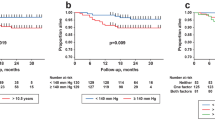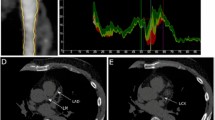Abstract
This study assessed the associations between microalbuminuria in asymptomatic patients with type 2 diabetes and the presence, extent, and severity of coronary atherosclerosis, as measured by coronary computed tomography angiography (CCTA), and the long-term clinical outcomes. In total, the study enrolled 284 consecutive eligible asymptomatic patients with type 2 diabetes and without known coronary artery disease (CAD), who then underwent CCTA and 24 h urine albumin measurements. Microalbuminuria was defined as 30–300 mg/day urinary albumin excretion. Obstructive CAD, as measured by CCTA, was defined as maximum intra-luminal stenosis ≥50 %. Patients with and without microalbuminuria were compared in terms of obstructive CAD prevalence, and the extent and severity of coronary atherosclerosis. They were evaluated using the following data: coronary artery calcium score (CACS), atheroma burden obstructive score (ABOS), segment involvement score (SIS) and segment stenosis score (SSS). All-cause mortality within a follow-up period of 5 years was also compared. Compared to patients without microalbuminuria, patients with microalbuminuria were more likely to have obstructive CAD (p = 0.004). Microalbuminuria was associated with higher ABOS (p = 0.010), SIS (p = 0.029), and SSS (p = 0.011), except for CACS (p = 0.058). Multivariable analyses adjusted for conventional cardiovascular risk factors revealed that microalbuminuria was an independent predictor of obstructive CAD [odds ratio 2.255, confidence intervals (CI) 1.121–4.538, p = 0.023] and all-cause mortality (hazard ratio 3.469, CI 1.319–9.121, p = 0.012). In asymptomatic patients with type 2 diabetes, microalbuminuria was associated with increased risk of CAD and poorer clinical outcomes.




Similar content being viewed by others
References
Becker A, Bos G, de Vegt F et al (2003) Cardiovascular events in type 2 diabetes: comparison with nondiabetic individuals without and with prior cardiovascular disease. 10-year follow-up of the Hoorn Study. Eur Heart J 24:1406–1413
Schramm TK, Gislason GH, Kober L et al (2008) Diabetes patients requiring glucose-lowering therapy and nondiabetics with a prior myocardial infarction carry the same cardiovascular risk: a population study of 3.3 million people. Circulation 117:1945–1954
Gerstein HC, Mann JF, Yi Q et al (2001) Albuminuria and risk of cardiovascular events, death, and heart failure in diabetic and nondiabetic individuals. JAMA, J Am Med Assoc 286:421–426
Arnlov J, Evans JC, Meigs JB et al (2005) Low-grade albuminuria and incidence of cardiovascular disease events in nonhypertensive and nondiabetic individuals: the Framingham Heart Study. Circulation 112:969–975
Abdulla J, Abildstrom SZ, Gotzsche O et al (2007) 64-multislice detector computed tomography coronary angiography as potential alternative to conventional coronary angiography: a systematic review and meta-analysis. Eur Heart J 28:3042–3050
Scholte AJ, Schuijf JD, Kharagjitsingh AV et al (2008) Prevalence of coronary artery disease and plaque morphology assessed by multi-slice computed tomography coronary angiography and calcium scoring in asymptomatic patients with type 2 diabetes. Heart 94:290–295
Rivera JJ, Nasir K, Choi EK et al (2009) Detection of occult coronary artery disease in asymptomatic individuals with diabetes mellitus using non-invasive cardiac angiography. Atherosclerosis 203:442–448
Min JK, Dunning A, Lin FY et al (2011) Age- and sex-related differences in all-cause mortality risk based on coronary computed tomography angiography findings results from the International Multicenter CONFIRM (Coronary CT Angiography Evaluation for Clinical Outcomes: An International Multicenter Registry) of 23,854 patients without known coronary artery disease. J Am Coll Cardiol 58:849–860
Chow BJ, Small G, Yam Y et al (2011) Incremental prognostic value of cardiac computed tomography in coronary artery disease using CONFIRM: COroNary computed tomography angiography evaluation for clinical outcomes: an InteRnational Multicenter registry. Circ Cardiovasc Imaging 4:463–472
Valmadrid CT, Klein R, Moss SE et al (2000) The risk of cardiovascular disease mortality associated with microalbuminuria and gross proteinuria in persons with older-onset diabetes mellitus. Arch Intern Med 160:1093–1100
Mattock MB, Barnes DJ, Viberti G et al (1998) Microalbuminuria and coronary heart disease in NIDDM: an incidence study. Diabetes 47:1786–1792
Yuyun MF, Dinneen SF, Edwards OM et al (2003) Absolute level and rate of change of albuminuria over 1 year independently predict mortality and cardiovascular events in patients with diabetic nephropathy. Diabet Med 20:277–282
Rose G, McCartney P, Reid DD (1977) Self-administration of a questionnaire on chest pain and intermittent claudication. Br J Prev Soc Med 31:42–48
Vandenbroucke JP, von Elm E, Altman DG et al (2007) Strengthening the reporting of observational studies in epidemiology (STROBE): explanation and elaboration. Epidemiology 18:805–835
American Diabetes Association (2010) Diagnosis and classification of diabetes mellitus. Diabetes Care Jan 33(Suppl 1):S62–S69
Raff GL, Abidov A, Achenbach S et al (2009) SCCT guidelines for the interpretation and reporting of coronary computed tomographic angiography. J Cardiovasc Comput Tomogr 3:122–136
Min JK, Shaw LJ, Devereux RB et al (2007) Prognostic value of multidetector coronary computed tomographic angiography for prediction of all-cause mortality. J Am Coll Cardiol 50:1161–1170
Hadamitzky M, Hein F, Meyer T et al (2010) Prognostic value of coronary computed tomographic angiography in diabetic patients without known coronary artery disease. Diabetes Care 33:1358–1363
Agatston AS, Janowitz WR, Hildner FJ et al (1990) Quantification of coronary artery calcium using ultrafast computed tomography. J Am Coll Cardiol 15:827–832
National Kidney Foundation (2002) K/DOQI clinical practice guidelines for chronic kidney disease: evaluation, classification, and stratification. Am J Kidney Dis 39:S1–S266
Levey AS, Bosch JP, Lewis JB et al (1999) A more accurate method to estimate glomerular filtration rate from serum creatinine: a new prediction equation. Modification of Diet in Renal Disease Study Group. Ann Intern Med 130:461–470
Haffner SM, Lehto S, Ronnemaa T et al (1998) Mortality from coronary heart disease in subjects with type 2 diabetes and in nondiabetic subjects with and without prior myocardial infarction. N Engl J Med 339:229–234
Lotufo PA, Gaziano JM, Chae CU et al (2001) Diabetes and all-cause and coronary heart disease mortality among US male physicians. Arch Intern Med 161:242–247
Cho E, Rimm EB, Stampfer MJ et al (2002) The impact of diabetes mellitus and prior myocardial infarction on mortality from all causes and from coronary heart disease in men. J Am Coll Cardiol 40:954–960
Howard BV, Best LG, Galloway JM et al (2006) Coronary heart disease risk equivalence in diabetes depends on concomitant risk factors. Diabetes Care 29:391–397
Wannamethee SG, Shaper AG, Whincup PH et al (2011) Impact of diabetes on cardiovascular disease risk and all-cause mortality in older men: influence of age at onset, diabetes duration, and established and novel risk factors. Arch Intern Med 171:404–410
Evans JM, Wang J, Morris AD (2002) Comparison of cardiovascular risk between patients with type 2 diabetes and those who had had a myocardial infarction: cross sectional and cohort studies. BMJ 324:939–942
Vaccaro O, Eberly LE, Neaton JD et al (2004) Impact of diabetes and previous myocardial infarction on long-term survival: 25-year mortality follow-up of primary screenees of the Multiple Risk Factor Intervention Trial. Arch Intern Med 164:1438–1443
Buyken AE, von Eckardstein A, Schulte H et al (2007) Type 2 diabetes mellitus and risk of coronary heart disease: results of the 10-year follow-up of the PROCAM study. Eur J Cardiovasc Prev Rehabil 14:230–236
Bulugahapitiya U, Siyambalapitiya S, Sithole J et al (2009) Is diabetes a coronary risk equivalent? Systematic review and meta-analysis. Diabet Med 26:142–148
Mattock MB, Morrish NJ, Viberti G et al (1992) Prospective study of microalbuminuria as predictor of mortality in NIDDM. Diabetes 41:736–741
Weir MR (2004) Microalbuminuria in type 2 diabetics: an important, overlooked cardiovascular risk factor. J Clin Hypertens 6:134–141; quiz 42–43
Rein P, Vonbank A, Saely CH et al (2011) Relation of albuminuria to angiographically determined coronary arterial narrowing in patients with and without type 2 diabetes mellitus and stable or suspected coronary artery disease. Am J Cardiol 107:1144–1148
de Zeeuw D, Parving HH, Henning RH (2006) Microalbuminuria as an early marker for cardiovascular disease. J Am Soc Nephrol 17:2100–2105
Sarnak MJ, Levey AS, Schoolwerth AC et al (2003) Kidney disease as a risk factor for development of cardiovascular disease: a statement from the American Heart Association Councils on Kidney in Cardiovascular Disease, High Blood Pressure Research, Clinical Cardiology, and Epidemiology and Prevention. Circulation 108:2154–2169
Go AS, Chertow GM, Fan D et al (2004) Chronic kidney disease and the risks of death, cardiovascular events, and hospitalization. N Engl J Med 351:1296–1305
American Diabetes Association (2013) Standards of medical care in diabetes—2013. Diabetes Care 36(Suppl 1):S11–S66
Greenland P, Alpert JS, Beller GA et al (2010) 2010 ACCF/AHA guideline for assessment of cardiovascular risk in asymptomatic adults: a report of the American College of Cardiology Foundation/American Heart Association Task Force on Practice Guidelines. J Am Coll Cardiol 56:e50–e103
Lauer MS (2010) Screening asymptomatic subjects for subclinical atherosclerosis: not so obvious. J Am Coll Cardiol 56:106–108
Vinik AI, Maser RE, Mitchell BD et al (2003) Diabetic autonomic neuropathy. Diabetes Care 26:1553–1579
Conflict of interest
None.
Author information
Authors and Affiliations
Corresponding authors
Rights and permissions
About this article
Cite this article
Kim, JJ., Hwang, BH., Choi, I.J. et al. A prospective two-center study on the associations between microalbuminuria, coronary atherosclerosis and long-term clinical outcome in asymptomatic patients with type 2 diabetes mellitus: evaluation by coronary CT angiography. Int J Cardiovasc Imaging 31, 193–203 (2015). https://doi.org/10.1007/s10554-014-0541-6
Received:
Accepted:
Published:
Issue Date:
DOI: https://doi.org/10.1007/s10554-014-0541-6




